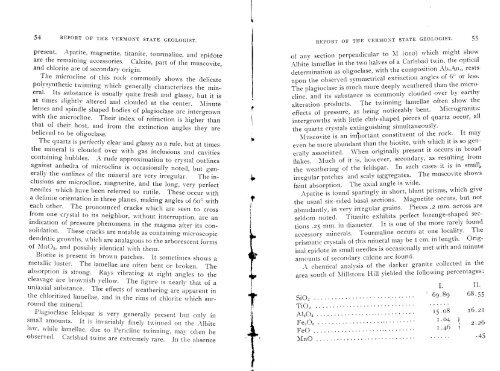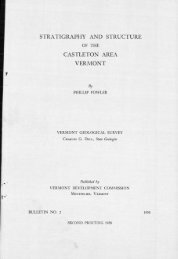Mineral Industries and Geology of Certain Areas - Vermont Agency ...
Mineral Industries and Geology of Certain Areas - Vermont Agency ...
Mineral Industries and Geology of Certain Areas - Vermont Agency ...
Create successful ePaper yourself
Turn your PDF publications into a flip-book with our unique Google optimized e-Paper software.
54 REPORT OF THE VERMONT STATE GEOLOGIST.<br />
present. Apatite, magnetite, titanite, tourmaline, <strong>and</strong> epidote<br />
are the remaining accessories. Calcite, part <strong>of</strong> the muscovite,<br />
<strong>and</strong> chlorite are <strong>of</strong> secondary origin.<br />
The microcline <strong>of</strong> this rock commonly shows the delicate<br />
polvsvnthetjc twinning which generally characterizes the rnineral.<br />
Its substance is usually quite fresh <strong>and</strong> glassy, but it is<br />
at times slightly altered <strong>and</strong> clouded at the center. Minute<br />
lenses <strong>and</strong> spindle shaped bodies <strong>of</strong> plagioclase are intergrown<br />
with the microcline. Their index <strong>of</strong> refraction is higher than<br />
that <strong>of</strong> their host, <strong>and</strong> from the extinction angles they are<br />
believed to he oligoclase.<br />
The quartz is perfectly clear <strong>and</strong> glassy as a rule, but at times<br />
the mineral is clouded over with gas inclusions <strong>and</strong> cavities.<br />
containing bubbles. A rude approximation to crystal outlines<br />
against anhedra <strong>of</strong> microcline is occasionally noted, but generally<br />
the outlines <strong>of</strong> the mineral are very irregular. The inclusions<br />
are microcline, magnetite, <strong>and</strong> the long, very perfect<br />
needles which have been referred to rutile. These occur with<br />
a definite orientation in three planes, making angles <strong>of</strong> 600 with<br />
each other. The pronounced cracks which are seen to cross<br />
from one crystal to its neighbor, without interruption, are an<br />
indication <strong>of</strong> pressure phenomena in the magma after its consolidation.<br />
These cracks are notable as containing microscopic<br />
dendritic growths, which are analagous to the arborescent forms<br />
<strong>of</strong> M110 2 , <strong>and</strong> possibly identical with them.<br />
Biotite is present in brown patches. It sometimes shows a<br />
metallic luster. The lamellae are <strong>of</strong>ten bent or broken. The<br />
absorption is strong. Rays vibrating at right angles to the<br />
cleavage are brownish yellow. The figtire is nearly that <strong>of</strong> a<br />
uniaxial substance. The effects <strong>of</strong> weathering are apparent in<br />
the chloritized lamellae, <strong>and</strong> in the rims <strong>of</strong> chlorite which sur -<br />
round the mineral.<br />
Plagioclase feldspar is very generally present but only in<br />
small amounts. It is invariably finely twinned on the Albite<br />
law, while lamellae, due to Pericline twinning, may <strong>of</strong>ten be<br />
observed. Carlsbad twins are extremely rare. In the absence<br />
ib<br />
.4,<br />
le<br />
REPORT OF THE VERMONT STATE GEOLOGIST. 55•<br />
<strong>of</strong> any section perpendicular to M (oio) which might show<br />
Aihite lamellae in the two halves <strong>of</strong> a Carlsbad twin, the optical<br />
determination as oligoclase, with the composition Ab<br />
3An 1 , rests<br />
upon the observed symmetrical extinction angles <strong>of</strong> 6 ° or less.<br />
The plagioclase is much more deeply weathered than the microdine,<br />
<strong>and</strong> its substance is commonly clouded over by earthy<br />
alteration products. The twinning lamellae <strong>of</strong>ten show the<br />
effects <strong>of</strong> pressure, as being noticeably bent. MicrogranitiC<br />
intergrowtlls with little club-shaped pieces <strong>of</strong> quartz occur, all<br />
the quartz crystals extinguishing simultaneously.<br />
Muscovite is an imortant constituent <strong>of</strong> the rock. It may<br />
even be more abundant than the biotite, with which it is so generally<br />
associatedl. When originally present it occurs in broad<br />
flakes. Much <strong>of</strong> it is, however, secondary, as resulting from<br />
the weathering <strong>of</strong> the feldspar. In such cases it is in small<br />
irregular patches <strong>and</strong> scaly aggregates. The muscovite shows<br />
faint absorption. The axial angle is wide.<br />
Apatite is found sparingly in short, blunt prisms, which give<br />
the usual six-sided basal sections. Magnetite occurs, but not<br />
abundantly, in very irregular grains. Pieces .2 mm. across are<br />
seldom noted. Titanite exhibits perfect lozenge-shaped sections<br />
.25 mm. in diameter. It is one <strong>of</strong> the more rarely found<br />
accessory minerals. Tourmaline occurs at one locality. The<br />
prismatic crystals <strong>of</strong> this mineral may be i cm. in length. Original<br />
epidote in small needles is occasionally met with <strong>and</strong> minute<br />
amounts <strong>of</strong> secondary calcite are found.<br />
A chemical analysis <strong>of</strong> the darker granite collected in the<br />
area south <strong>of</strong> Millstone Hill yielded the following percentages:<br />
I. II.<br />
Si02 .............................69.89<br />
68.55<br />
Ti0 2 ..................................<br />
A123 C) .............................i.o8 16.21<br />
Fe 203 ............................. 1.04<br />
2.26<br />
1.46<br />
FeO<br />
MnO...................................













